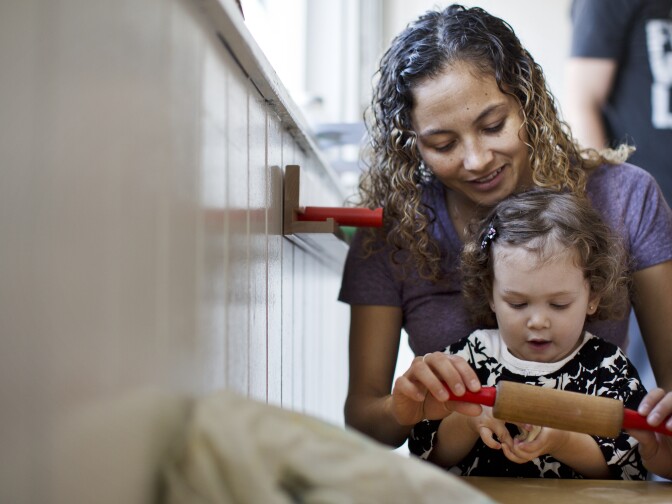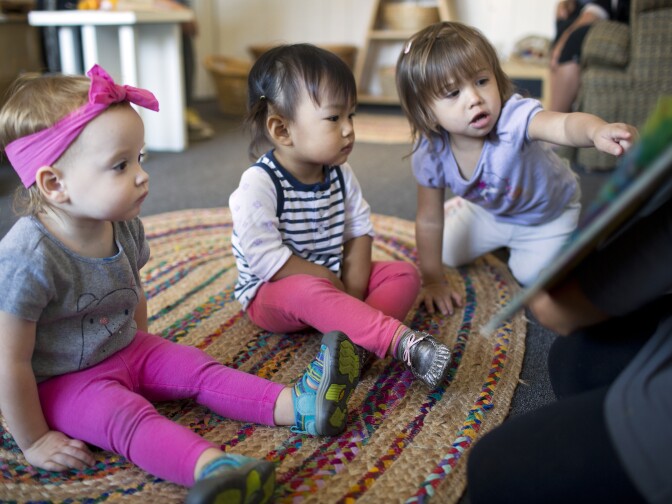Truth matters. Community matters. Your support makes both possible. LAist is one of the few places where news remains independent and free from political and corporate influence. Stand up for truth and for LAist. Make your year-end tax-deductible gift now.
This archival content was originally written for and published on KPCC.org. Keep in mind that links and images may no longer work — and references may be outdated.
Teaching Spanish to the kids isn't easy for second-generation parents
One recent Saturday morning inside a small storefront classroom in Long Beach, preschoolers, toddlers and their parents bounced along to a Spanish-language song. Afterward, they talked amongst themselves in Spanish – some with more difficulty than others.
The place is called The Family Nest, a part-time Spanish immersion school for young children. The parents that come here are mostly Latino. But many aren't immigrants – or, for that matter, great Spanish speakers.
Some have had to work at it - and still are, along with their kids.
“It’s challenging, because I’ve spoken English for 30 years of my life," said Mariela Salgado, who attends classes there with her two young daughters. "I've been in American schools all my life. I have an MBA. I worked in corporate America. So English has been my primary language."
Salgado arrived with her family from Mexico when she was three. She grew up in Culver City and went to school in Brentwood. Later, she attended Pepperdine University, and assimilated - just as her parents had hoped.
Then she got married, and had kids. That got Salgado and her husband thinking about the cultural legacy they'd leave their children.
"For me, tradition will be passed down with Spanish," Salgado said. "So it's important that both my girls learn Spanish."
The challenge?
"Because I speak English so much better at this point, I don’t speak enough Spanish to them." Salgado said.
Welcome to the future of Spanish in America.
According to the Pew Research Center, by now more than half the nation's adult Latino population is U.S.-born. Meanwhile, fewer immigrants are arriving from Latin America.
What this means is that gradually, the U.S. is seeing a shrinking number of Spanish-speaking households. It’s expected that by 2020, only two-thirds of U.S. Latino households will speak Spanish.
“The Census Bureau projects that in just a few years, we are going to reach about one-third of Hispanic young people living in a household where only English is spoken," said Mark Hugo Lopez. director of Hispanic research with the Pew Research Center.
More of these young people are intermarrying – at least a quarter have non-Latino partners, Lopez said. Throw in busy lives, with work, school, and other obligations, and teaching Spanish to one's kids isn’t easy.
Now here's where I take this story into the first-person: I'm one of those parents.
My parents brought me to the U.S. from Cuba when I was three. Today, I'm raising a nine-year-old daughter, Lucia. And teaching her Spanish has been, well, challenging. Like the time I spent taking her to weekend Spanish immersion classes when she was younger.
“I thought that the weekend Spanish school for me, when I was about 5 to 6, I hated it!" Lucia said when I asked her about it the other day. "My teacher only spoke Spanish and didn’t translate.”
After more tantrums than I care to remember, I gave it a rest. We tried applying out-of-district to dual-immersion public school, but didn't get in. These days, I try my best to pepper our daily routine with Spanish, but it isn't much.
Lucia understands more Spanish than she lets on, but she's reluctant to speak it. Asked a question in Spanish, she replies in English.
On weekends when we visit my parents, my mother, Haydee, drills Lucia on her Spanish vocabulary. She wishes I were trying harder.
"It's a shame, a little bit of a shame, that she doesn't speak more Spanish," my mother said. "She could be more fluent by now."
After all, I'm bilingual - thanks largely to my parents' insistence when I was growing up that I always speak Spanish at home. But I had to brush up, too. I took Spanish in high school and in college. Even so, English is my daily default.
Parents like these often wind up The Family Nest with their kids, said owner Maria Palazzolo. It's one of a handful of private, part-time Spanish bilingual education schools in the Los Angeles area for young children. On Saturday mornings, families are invited to join in and socialize together with their kids.
Palazzolo said in some ways it's part school, part support group.
“More than anything I have found that a lot of the moms that come here feel supported," Palazzolo said. "They are like, whew, I am not the only one! There are other people going through the same thing.”
This includes Palazzolo - formerly Trujillo - whose background is in early childhood education. She’s Mexican American, raised in Long Beach. Her husband is Italian and Filipino. She didn’t speak any Spanish at home until her son, Massimo, was born three years ago.
“Once I started talking to him in Spanish, I realized, wow, this is harder than I thought!" Palazzolo said. "I needed to brush up on my Spanish a little bit more. That’s when I decided to have a program that will support that.”
She started meet-ups for moms who could brush up on their Spanish together, while their little ones learned, too. She opened the storefront classroom last spring.
Like many of her clients, Palazzolo would like to enter her son in dual-immersion classes, in which native-speaker kids learn along with non-native speakers. But these can be hard to get into, Palazzolo said. Some school districts don't have them. In the end, much is up to the parents.
Both Palazzolo and Salgado have tried to brush up on their Spanish with a number of tools: Apps, dictionaries, Google Translate, trying to muddle their way through Spanish-language media. Even relatives have been enlisted to help.
"I do make an effort on a daily basis," Salgado said, "looking up words on Google or online to remember what they sound like. Even with my mother. I actually have conversations in Spanish with my mother. I didn’t for a long time. I always used to talk to her in English."
Salgado said she grew up in the 1980s in a household where assimilation was stressed; her father insisted she perfect her English to get ahead.
Pew's Mark Hugo Lopez says this isn't uncommon - and that some of these same people are the ones rediscovering Spanish.
"Back in the fifties, sixties, even in the seventies, depending on the part of the country, (people) were really being told that they should be speaking English, and be American," Lopez said. "But today, for young Latinos, it's rather more a story of 'speak Spanish and be proud of your heritage.'"
Lopez said these days, it's not uncommon to see young, English-dependent Latinos signing up for college Spanish courses.
Carol Venegas-Schuster, another Family Nest mom, said she came close to losing her Spanish at one point. She eventually took Spanish classes as an adult.
It helps these days that her husband is from Spain - but so does attending mommy-and-me classes with her toddler. She says her Salvadoran immigrant parents are impressed.
"They are very happy that my Spanish sounds better, because I can express myself better," Venegas-Schuster said. "Before they would correct me all the time, or my dad would say, 'You can't speak Spanglish!'"
Salgado said she wants to pass much more than a language along to her children.
"For us, it is not about that second language necessarily, it’s about that identity for ourselves, who we are, what piece of us to pass on to our kids," Salgado said.
For Palazzolo, it's also passing on a sense of respect for "how much my parents struggled to be here, and how much they had to go through."
My mother describes it like this: "We are passing traditions," she said, "and lots of things that we were taught by our parents and our grandparents – and the love of family.”
So what happens if we try and fail? Not all is lost, according to Nina Hyams, a linguistics professor at UCLA.
"There has been some interesting research that shows that even children who don’t actively speak the language themselves as children, if they are exposed to it, at least in the home setting, then later in life, say when they are in college and they want to actually learn their heritage language...they have an advantage," Hyams said.
These Spanish learners won't necessarily have an advantage when it comes to learning grammar, Hyams said, but they'll have an easier time with pronunciation, and acquiring a native-like accent.
It's a ray of hope, at least. The other day, after school, my daughter Lucia told me she’d learned the name of the Spanish priest who founded the first California missions.
“My teacher was pronouncing it Joo-ni-pero Serra," she complained.
Then she said it in perfect Spanish: Junípero Serra. Accent and all.















